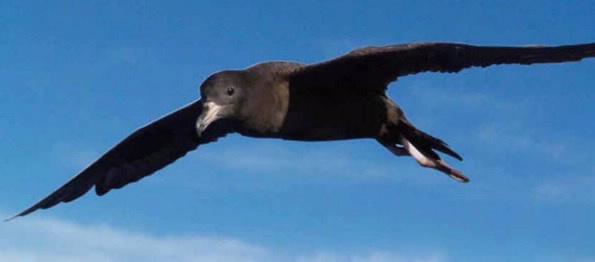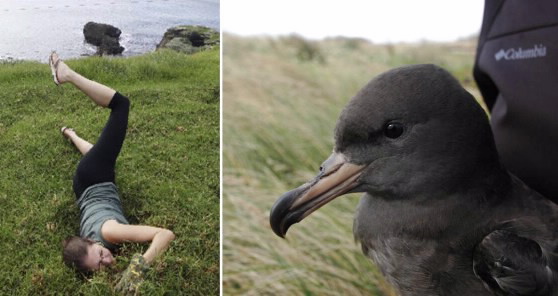Australian scientists using brand new techniques to study the shearwater seabird have made stunning discoveries about the ongoing impact that plastics in the water can have on marine life.
 |
| Flesh- footed Shearwater (Puffinus carneipes) |
Described as ‘sentinels’ by Nobel prize-winner Peter Doherty, birds continually sample oceans and the atmosphere, so their study helps scientists understand environmental changes and dangers.
This latest study has involved scientists from Australian universities, ANSTO and the Australian Synchrotron. The scientists analysed the breast feathers of the common Mutton Bird and the Streaked Shearwater to confirm the presence of plastics and associated chemicals in the marine food chain.
However unlike previous techniques, instead of grinding the feather to ash and analysing its composition under a mass spectrometer, they scanned and analysed the whole feather with the state-of-the-art X-ray fluorescent microprobe imaging beam line at the Australian Synchrotron.
 |
| A highly conserved previously undescribed regular banding pattern of Zn deposition in the breast feathers of Flesh-footed Shearwater chicks visualised at the Australian Synchrotron. |
Scientists discovered in breast feathers a never before seen, regular pattern of bands with high zinc concentrations running the full length of a feather and reminiscent of tree rings.
There were about the same number of rings as days in a month of feather growth – meaning evidence was found of chemicals in a bird’s metabolism: an oscillating biological process. This raises the possibility that distribution of elements such as zinc, mercury and cadmium in a feather can be used as indicator of a bird’s health – because they are circulated in its metabolism.
The project was awarded the Cannon Extreme Imaging Awards, which will be announced tonight in Sydney.
 |
| The research team included Professor Richard Banati, Dr Richard Garrett and Nicholas Howell from ANSTO, Dr Jennifer Lavers from Monash University, Sayaka Uematsu and Dr Brad Congdon from James Cook University and Dr David Patterson, Dr Daryl Howard and Dr Kathryn Spiers from the Australian Synchrotron. In this image Dr Lavers is collecting feather samples from chicks of the Flesh-footed Shearwater (Puffinus carneipes). |
KEY FACTS : Radiation X-Ray Fluorescence microprobe imaging of seabird feathers
- As the Shearwater seabird seasonally journeys in a figure of eight across the equator from the Northern to the Southern hemisphere, from the waters of Japan and Siberia to the waters of Australia, it feeds, never touching land, on marine life from very different environments - some polluted, others still pristine.
- Its organs and feathers carry the signature of its diet and thus the state of the environment along its travelled route. For this reason, seabirds are studied as bio-indicators in ecotoxicology. They are sentinels for the health of the world’s marine ecosystems and the life that feeds on it.
- Using the new state-of-the-art X-ray fluorescent microprobe imaging beam line at the Australian Synchrotron, a team of researchers from several Australian universities and ANSTO have measured with unprecedented sensitivity and resolution the distribution of important atomic elements in seabird feathers.
- Breast feathers were collected from two species of tube-nosed seabirds (Procellariiformes), the Flesh-footed Shearwater (Puffinus carneipes), also known locally as the Mutton Bird, and the Streaked Shearwater (Calonectris leucomelas).
- Amongst other observations, the scientists discovered in breast feathers a never before seen, strikingly regular pattern of bands with high zinc concentrations. It runs along the full length of a feather and is reminiscent of tree rings. Since the Shearwater’s breast feathers grow over a period of roughly one month and the number of bands with high zinc concentration is approximately the same as the number of days in a month, there is, hidden in the unassuming, dark to light grey breast feathers unexpected evidence that there may be daily oscillation in the metabolism of the bird that is in synchrony with its physiological growth cycle.
- Zinc is a vital nutrient in animal metabolism. The ability not only to measure its concentrations but also link variations to important biological functions over time, such as feather growth, raises the possibility that distributions of the atomic elements in bird feathers can be used as indicators of bird health.
- The research team also studied the distributions of other elements, such as calcium, arsenic, bromine, and iron, some of are due to the up-take of pollutants.
- The challenges facing the Shearwater bird are numerous: habitat degradation and loss, change in ocean productivity influenced by sea-surface temperature anomalies, human activities, such introduced mammalian predators, and by-catch mortality associated with fishing. Monitoring and conservation of seabirds is crucial for our understanding of marine environmental health, both locally and internationally. The use of extremely sensitive nuclear techniques, such as Synchrotron Radiation X-Ray Fluorescence Techniques, helps to shine light on whether and how seabirds are affected by the many challenges they face as they roam across the globe.


